|
Common names:
Australia |
English |
silver-lined mudskipper |
China |
Chinese Mandarin |
银线弹涂鱼, 銀線彈塗魚 (yin xian tan tu yu - silver-lined mudskipper) |
Denmark |
Danish |
båndet dyndspringer |
Guam |
English |
barred mudskipper |
Indonesia |
Javanese |
blodok |
Italy |
Italian |
perioftalmo argentato* |
Japan |
Japanese |
minami tobihaze |
Micronesia |
English |
barred mudskipper |
New Caledonia |
Kumak |
bwaxit |
Papua New Guinea |
English |
barred mudskipper |
Philippines |
Tagalog |
bia |
Solomon Islands |
Gela |
iga kukulu mana |
Solomon Islands |
English |
silver-lined mudskipper |
South Africa |
English |
bigfin mudhopper |
South Africa |
Afrikaans |
Grootvin-modderspringer |
United Kingdom |
English |
barred mudskipper, silver-lined mudskipper |
* proposed name
|
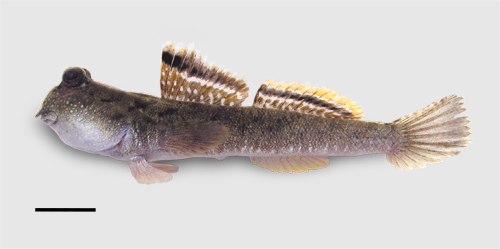
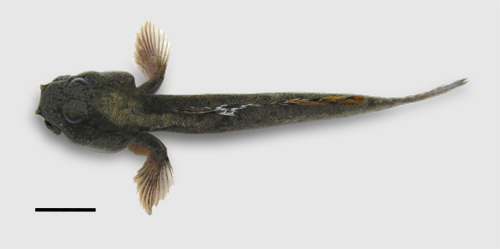
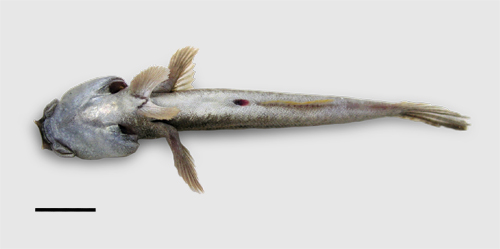
Periophthalmus argentilineatus. Morib, peninsular Malaysia;
lateral view (above); dorsal view (centre); ventral view (below);
the bar is 10 mm long - freshly dead specimen, male (photo: G. Polgar, 2006)
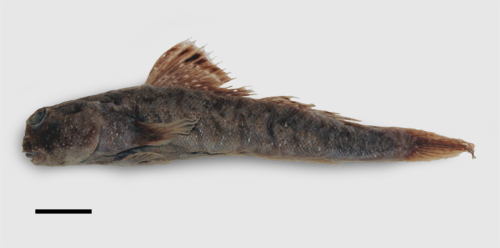
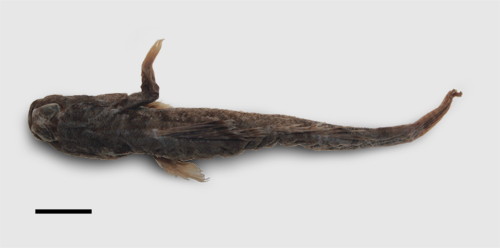
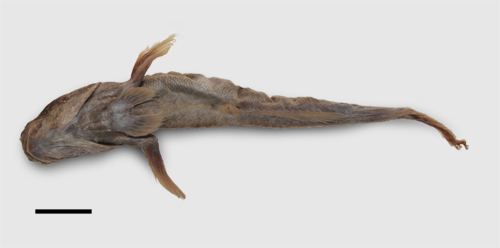
Periophthalmus argentilineatus. RMNH 4593, coll. Bleeker 1879
possible syntype (according to Murdy, 1989) of Periophthalmus dipus Bleeker, 1854
Sumatra, Java, Flores (Eggert, 1935);
lateral view (above); dorsal view (centre); ventral view (below);
the bar is 10 mm long - specimen fixed and preserved in ethanol, male
(photo: G. Polgar, 2007)
|
|
Synonyms:
|
Periophthalmus argentilineatus |
Valenciennes, 1837* |
(senior syn., original combination) |
|
Periophthalmus dipus |
Bleeker, 1854 |
(junior synonym) |
Periophtalmus koelreuteri argentilineata |
Bianconi, 1857 |
(invalid, mispelled) |
|
Euchoristopus kalolo regius |
Whitley, 1931 |
(junior synonym) |
|
Periophthalmus argentilineatus argentilineatus |
Valenciennes, 1837* |
(senior synonym)** |
|
Periophthalmus argentilineatus striopunctatus |
Eggert, 1935 |
(junior synonym) |
|
Periophthalmus dipus angustiformis |
Eggert, 1935 |
(junior synonym) |
|
Periophthalmus dipus dipus |
Bleeker, 1854 |
(junior synonym)** |
|
Periophthalmus dipus parvus |
Eggert, 1935 |
(junior synonym) |
|
Periophthalmus sobrinus |
Eggert, 1935 |
(junior synonym) |
|
Periophthalmus vulgaris ceylonensis |
Eggert, 1935 |
(junior synonym) |
|
Periophthalmus vulgaris notatus |
Eggert, 1935 |
(junior synonym) |
|
Periophthalmus vulgaris regius |
Whitley, 1931 |
(junior synonym)** |
|
Periophthalmus vulgaris vulgaris |
Eggert, 1935 |
(junior synonym) |
*In: Cuvier & Valenciennes, 1837
**sensu Eggert (1935)
Type catalog (last update: 15/08/2007)
Etymology:
'Periophthalmus' is a compound name from the Greek 'peri' (around), and 'ophthalmôn' (eye), which refers to the wide visual field of these species
'argentilineatus' means 'silvery-lined' in Latin, which refers to the vertical silvery stripes on flanks
(Murdy, 1989)
|
Maximum recorded length:
93 mm SL (Murdy, 1989)
Live colouration
(Murdy, 1989; Takita et al., 2011; pers. obs.: Peninsular Malaysia, North Sulawesi, Australia NT):
background colour brownish to dark grey on dorsum and sides, ventrally whitish; head
ventrally white; many small white speckles on cheeks and opercula; silvery
vertical stripes on flanks, ventrally more evident; 3-8 dorsal dark brown saddle-like irregular bars may be visible; D1 with a reddish to brownish background, a wide black to dark brown inframarginal stripe, which can be darker in the anterior portion
(e.g. photos H, L), and many small white spots below it; margin white to transparent. D2 with a black medial stripe; with irregular brownish speckles proximally on rays and membrane (which can coalesce to form a brownish
background with a few or no white spots); and with a yellow to red margin; caudal fin dusky, with series of dusky to brownish speckles along rays; anal fin background
hyaline, in some specimens distally dusky to orange; pectoral fins dusky; pelvic fins proximally darker, ventrally whitish, and dorsally whitish to yellowish
Colouration on preservation
(Murdy, 1989; pers. obs.):
ground colour dorsally and laterally grey to dark brown, ventrally whitish to dusky; some few whitish speckles may be preserved in some specimens; vertical
silvery stripes are more visible in the ventral portion of sides; dark and irregular dorsal banded pattern frequently visible; D1 background brownish
to slate, many scattered white spots proximally and a conspicuous blackish inframarginal stripe; margin pale to transparent;
D2 brownish with a dark brown to black medial stripe and scattered whitish spots on proximal membrane in some specimens; caudal fin dusky with series of
dark speckles on rays; pectoral fins dusky; pelvic
fins white ventrally, dorsally dusky; anal fin white
Diagnosis (Murdy,
1989):
D1 XI-XVI; total D2 elements 10-13; total anal fin elements 9-12; TRDB 18-26; longitudinal scale count 64-100; head width 14.3-22.6%SL; pelvic fin
length 11.3-15.2%SL; length of anal fin base 14.0-19.4%SL; length of D2 base 17.6-23.7%SL; pelvic fins almost completely to totally separated, pelvic frenum
absent; D1 margin concave or straight; dorsal fins not connected by membrane; D1 with a dark inframarginal stripe and numerous white spots at least in the proximal portion; no elongated spines.
At least in some East African populations, the reddish D2 margin is absent in adult reproductive females (Magnus, 1981).
See the remarks on P. kalolo about the discrimination between these two species.
The genus is yet undefined by synapomorphies
Diet:
carnivorous, opportunistic, apparently only gape-limited (insects, crustaceans, fish eggs, polychaetes, etc.: Milward, 1974); nonetheless, different selectivity and feeding regimes had been observed in the two sexes, suggesting different reproductive strategies through the tidal synodic cycle; these studies also put in evidence that at least in East African populations, this species is both a diurnal and a nocturnal feeder (Colombini et al., 1996)
|
|
Reproduction:
males dig reproductive burrows below the MHWN datum (Mean High Water Neap, in front of the first trees of the mangrove forest) in areas not covered by the vegetation, and jump with the spread fins to attract females from the distance, then inducing them to spawn inside their
burrows; during the period of cohabitation consecutive spawning events take part; then only the male guards the eggs,
always remaining nearby the nest and maintaining an air phase
in the egg chamber; during high tide, when the nest is submerged, the male enters the burrow (Brillet, 1969a; 1970; 1975; 1976; 1980;
Magnus, 1981)
left: a male during a phase of the courtship sequence (tail waving)
right: an individual gulps air to transport it inside the burrow
(photos: left: Y. Ikebe, southern Japan, (© Mudskipper World, 2008); right: frame from Magnus, 1981)
|
|
|
|
|
Ecological notes (pers. obs.: Peninsular Malaysia, North Sulawesi, Australia NT):
locally common on higher mudflats at low tide, usually at a distance of less than 2 m from the water, not far from mangrove vegetation, typically along creek banks, and around tide pools in pioneer mangrove forests.
During ebb tide, P. argentilineatus follows the water edge to feed on the higher mudflat or on the mud banks of tidal waterways (Brillet, 1975; Magnus, 1981; Takita et al., 2011; pers. obs); during flood
tide the fishes follow the tide again, keeping out of water: they can either take refuge inside burrows, or climb roots and trunks (not unlike P. chrysospilos), or can simply wait at the water's edge, their heads directed towards the water (Magnus, 1981). However, the details of the intertidal movements of this species may be more complex, being also related both with tidal synodic and diel light cycles (Colombini et al., 1995)
left: bank of a tidal point bar of a creek fringed by Avicennia sp. mangroves, a typical habitat where P. argentilineatus can be found at low tide
(Likupang, North Sulawesi, Indonesia)
right: a P. argentilineatus perching on a trunk of Avicennia alba, waiting for the low tide (Tg. Piai, peninsular Malaysia)
(photos by G. Polgar; left: 2005; right: 2006)
|
|
|
|
|
Distribution (Murdy, 1989):
from the Red Sea and the east coast of Africa, eastward to Southern Japan, Australasia and Oceania, up to Samoa Islands;
type localities: Irian Jaya and Moluccas, Indonesia.
This distribution is the widest of all oxudercine gobies
|
|
|
Remarks:
See Periophthalmus kalolo.
Molecular phylogenetic analyses suggest that this species includes at least three cryptic species (Polgar et al., 2014), one being morphologically consistent with P. sobrinus Eggert (pers. obs.; recorded from the Red Sea, southward to East Africa), one morphologically consistent with P. vulgaris Eggert (pers. obs.; recorded from Sri Lanka eastward to
west Sumatra, Sunda Islands, Sulawesi, Philippines, Moluccas, West Papua and northern Australia); and one morphologically consistent with P. argentilineatus Valenciennes (pers. obs.;
recorded from west Sumatra, eastward to Sunda Is., southeast Borneo and the Moluccas)
|
Photographs of Periophthalmus argentilineatus:
|
|
A: individuals taking shelter on an emerging
rock at high tide: in this case, intraspecific aggressiveness is inhibited (photo: Y. Yoshida, Isahaya Bay, Japan © isahayawan); B: jumping P. argentilineatus: note the fins which are depressed and adherent to the body;
C: a specimen with a crab in its mouth, threatening an opponent by flagging its first dorsal fin and darkening its snout; D: several
specimens climbing on the palm of the photographer (photo B-D: A. Kamiya "Yamaneko", Ohashi inlet, Japan, 2001 © umisuzume, 2007)*; E: freshly dead Fijian
specimen (photo: J. Randall, Fiji Islands, 1973; fishbase, 2007); F: freshly dead Indonesian specimen (photo: J. Randall, Ambon Bay, 1975; fishbase, 2007); G: another freshly dead Indonesian
specimen (photo: G. Polgar, North Sulawesi, 2005); H: freshly dead Australian specimen (photo: G. Polgar, Vestey's Creek, Darwin, Australia NT, 2007); I: an individual in aquarium threatening
the hand of the observer; J: ventral view of the pelvic fins (photo I, J: M. Tanabe, © Marli's mudskipperland, 2007);
K: an Australian specimen at low tide (photo: G. Polgar, Doctor's Gully, Darwin, Australia NT); L: two specimens in an aggressive encounter (photo L. Mráz, South Africa, St. Lucia estuary, cape Vidal, Sugar Loaf, 2005 © naturephoto-CZ)* - * with permission
|
Drawings of Periophthalmus argentilineatus:
A: cephalic sensory and nasal pores of Periophthalmus spp.: an = anterior nostril; pn = posterior nostril
(modified from Murdy, 1989)*; B: Periophthalmus vulgaris regius Eggert, 1935 (Eggert,
1935); C: Euchoristopus dipus (Bleeker) (Bleeker, 1983)*; D: Euchoristopus argentilineatus (Valenciénnes) (Bleeker, 1983)* - * with permission
|










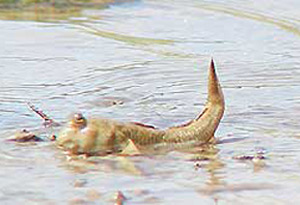
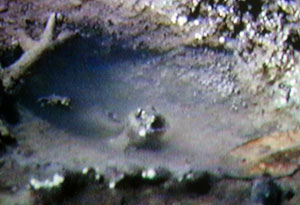
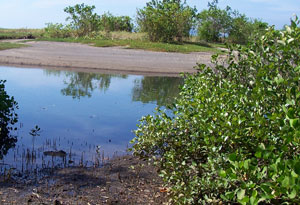
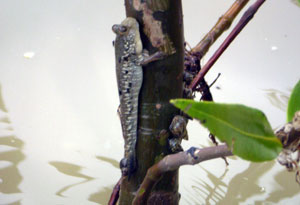
![]()